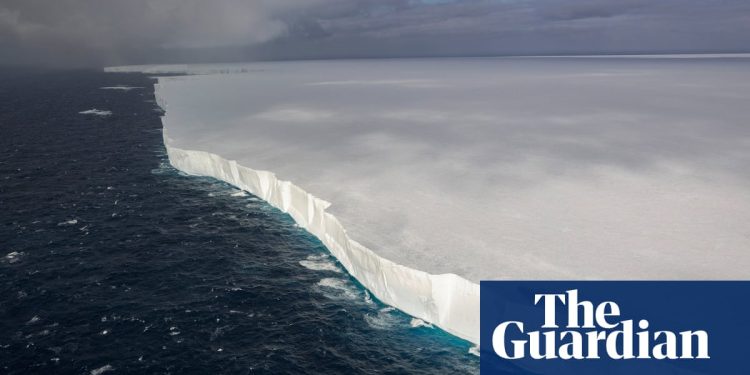The largest iceberg in the world – a giant more than twice the size of London – drifts to a remote island where scientists say that it could run up and threaten penguins and seals.
The gigantic wall of ice slowly moves from Antarctica on a potential collision trajectory with southern Georgia, a crucial wildlife reproduction ground.
Satellite imagery suggested that, unlike the previous “megabergs”, this thug does not collapse in small pieces while crossing the South Ocean, said Andrew Meijers, a physical oceanograph in the British investigation in Antarctic.
He said the forecast of his exact course was difficult, but the dominant currents suggested that the Colossus would reach the shallow continental plateau in the south of Georgia in two to four weeks.
But what could happen next is someone’s assumption, he said.
It could avoid the tray and be transported in water doors in water beyond southern Georgia, a British territory abroad at around 1,400 km (870 miles) east of the Falklands Islands.
Or it could strike the bottom sloping, get stuck for months or separate into pieces.
Meijers said that this scenario could seriously hinder seals and penguins trying to feed and raise their young people on the island.
“The icebergs have anchored it in the past and it has caused significant mortality to penguin chicks and puppies,” he said.
About 3,500 km2 (1,550 km2), the oldest and oldest iceberg in the world known as A23A has gripped the Antarctic plateau in 1986.
He remained stuck for more than 30 years until finally freeing himself in 2020, his trip of exclusion to the north sometimes delayed by the ocean forces which kept him in place.
Meijers – who met the iceberg face to face while leading a scientific mission at the end of 2023 – described “a huge white cliff, 40 or 50 meters high, which extends from the horizon to the horizon”.
“It’s like this white wall. It is very a kind of Game of Thrones-Esque, in fact, “he said, describing” having the impression that it would never end “.
The A23A followed almost the same path as the previous massive icebergs, passing the east side of the Antarctic Peninsula through the Weddell Sea along a road called “Alley of Iceberg”.
Weighing a little under a tonnes Billion, this monster block of fresh water was taken by the more powerful ocean “jet stream” in the world – the circumpolar current of the Antarctic.
Meijers said that it followed “more or less a straight line from which he is now towards southern Georgia” where the waters quickly become shallow and that the current suddenly bends.
The iceberg could follow this current towards the sea or fail on the shelf, he said.
It is summer in southern Georgia and the penguins and resident seals along its southern coast undertake food expeditions to icy waters to bring enough food to fatten their young people.
“If the iceberg throws itself there, it will block physically where they will feed, or they will have to get around it,” said Meijers.
“It burns an enormous amount of additional energy for them, so it’s less energy for puppies and chicks, which causes increased mortality.”
The populations of seal and penguin on southern Georgia have already had a “bad season” with an epidemic of bird flu “and that (iceberg) would aggravate a lot,” he said.
“It would be quite tragic, but it is not unprecedented.”
As A23A finally melted, it could litter the ocean with small pieces of ice – but always dangerous – difficult to sail, added Meijers.
It would also sow water with nutrients that encourage the growth of phytoplankton, the diet of whales and other species, and allowing scientists to study how such flowers absorb carbon dioxide from the atmosphere.
While the icebergs were very natural phenomena, Meijers said that the speed at which they were lost in Antarctica increased, probably due to the climate crisis induced by humans.


